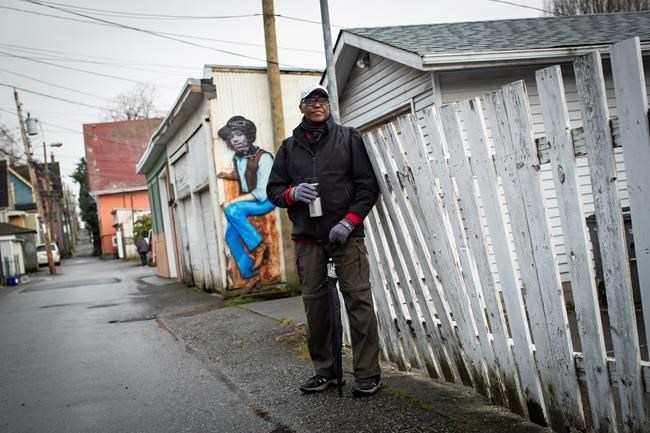VANCOUVER — When Randy Clark wants to return to the home where he spent his formative years from 12 to 16, it means gazing at a viaduct that many credit with the destruction of Vancouver's historic Black community.
The house where Clark lived with his mother and four of his 10 siblings was demolished in 1970 alongside others that backed onto "Hogan's Alley."
The city approved the construction of the Georgia viaduct under a banner of "urban renewal," but it came at a cost to those who called it home.
"That's where the viaduct currently rests, on that piece of property," Clark, 67, said in an interview.
Clark is part of a group hoping to see a revitalization of the area with acknowledgment of Vancouver's Black history.
Hogan's Alley is named for a T-shaped laneway that ran for several blocks in Vancouver's Strathcona neighbourhood.
Black settlement in the area dates back to 1858 when governor James Douglas introduced a policy welcoming Black Californians to British Columbia. The Great Northern Railway station nearby also meant many Black porters chose Hogan's Alley as a home in the 1920s.
The area east of downtown was also home to Italian, Chinese, Japanese, First Nations and Jewish residents, many of whom were prevented from living in other neighbourhoods by racist housing policies, said Lama Mugabo, a board member with Hogan's Alley Society.
At the height of its vibrancy, Hogan's Alley was an entertainment district attracting the likes of Sammy Davis Jr. and Ella Fitzgerald. Jimi Hendrix would visit his grandmother Nora Hendrix, who was an active member of the African Methodist Episcopal Fountain Chapel and cooked at Vie's Chicken and Steak House, which was owned by Clark's grandparents.
"It was a place where people came to party, people came to enjoy soul food, to listen to jazz. All the great musicians, when they came to town, they ended up in Hogan's Alley," Mugabo said.
Over the years, the neighbourhood met challenges. The city's efforts to rezone Strathcona made it difficult for residents to obtain mortgages or loans for home improvements. Newspaper articles portrayed Hogan's Alley as a centre of squalor, immorality and crime, the Vancouver Heritage Society says.
Clark said he remembers a lack of garbage pickup by the city compared with other neighbourhoods and debris piling up on lots. When he moved in, plans for the freeway had been announced and an exodus of residents was underway.
"It was very noticeable to me that that area where I lived was not being kept up," Clark said.
The city began bulldozing houses in 1967 and the Georgia and Dunsmuir viaducts opened in 1972, although plans for a larger freeway never came to fruition.
"For us, these viaducts constitute the monuments of our displacement," Mugabo said.
The impact continues as Black people move into Vancouver and find no cultural core, he said.
Mugabo moved to Vancouver in the 1980s from Rwanda and said he could relate to the story of Hogan's Alley and was drawn to efforts to revitalize it.
"As a political refugee, I know what displacement is. Also, as a Black man, I know how violent racism has been and the impact of racism on our community," he said.
More than 50 years after the viaducts were built, city council voted to take them down in 2015.
The society spent two years consulting the community and meeting with various city departments to submit a proposal that would allow for affordable housing, a cultural centre and business and retail space in their place, Mugabo said.
Ultimately, the society wants a community land trust on the block that would protect the area for public use under a long-term lease.
"The work we're doing today is not about us, it's not for us. It's for our children's children," he said.
The society's proposal has been embedded in the city's northeast False Creek Plan, but some elements remain unfulfilled, including the signing of a memorandum of understanding with the society, Mugabo said.
No one from the city was available for an interview, but it said in a statement that it is continuing discussions with the society on establishing an agreement, including consideration of a land trust.
However, it said the 20-year plan, which includes revitalization of the Hogan's Alley block and removal of the viaducts, relies on development funding and timing to deliver public benefits.
"The City recognizes that this is only the initial stage in building a relationship with the Hogan's Alley Society and the larger Black community, and sees this work as crucial to the long-term success of the city's cultural redress efforts with Vancouver's Black and African diaspora communities," the statement said.
The city said it's committed to prioritizing the needs of Black people who face racism and persistent social and economic exclusion, including work to address historic wrongs and to remove barriers to full participation of their cultures.
It is also in the process of creating a planning position to address systemic anti-Black racism, the statement said.
Clark said he's hoping the neighbourhood has a bright future, but instead of doing so under the umbrella of "revitalization," he chooses to reclaim a different phrase.
"I'm going to use another word: Renewal."
This report by The Canadian Press was first published Feb. 9, 2021.
Amy Smart, The Canadian Press



